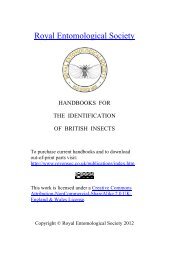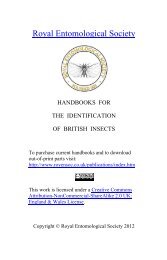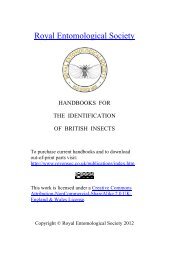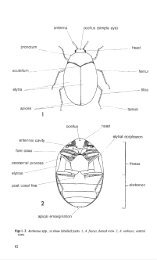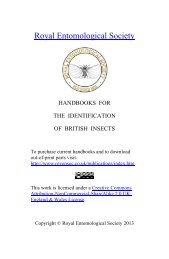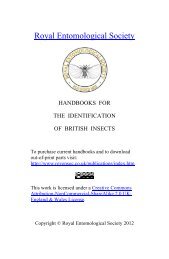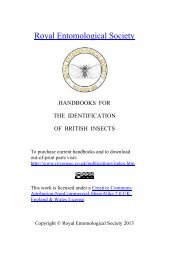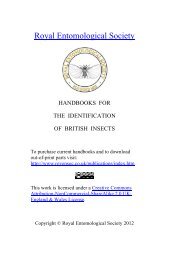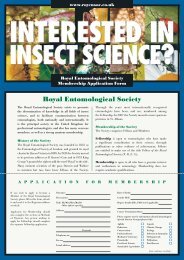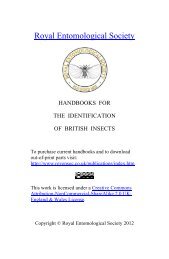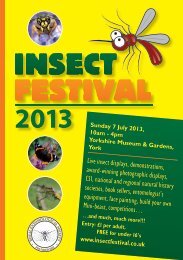Vol 5 Part 12. Coleoptera. Cerambycidae. - Royal Entomological ...
Vol 5 Part 12. Coleoptera. Cerambycidae. - Royal Entomological ...
Vol 5 Part 12. Coleoptera. Cerambycidae. - Royal Entomological ...
- No tags were found...
You also want an ePaper? Increase the reach of your titles
YUMPU automatically turns print PDFs into web optimized ePapers that Google loves.
LAMIINAE 13* Neoclytus.1 Elytra each with a pair of apical spines. Thorax entirely red. Length 7-13 mm.*N. acuminatus Fabricius.Elytra without apical spines ; evenly rounded. Thorax black with front marginyellow. Length 8·5-17 mm ..............................................*N. caprea Say.• 1(*) Plagionotus.Apical third of elytra yellow with two transverse black bands (the posterior oneoften incomplete) and apex emarginate. Scutellum brown. Length 13-17 mm.* P. detritus (Linnaeus).Apical third of elytra black, with two transverse yellow bands and apex rounded.Scutellum bright yellow. Length 9- 18 mm. ............* P. arcuatus (Linnaeus).Anaglyptus.1 Antenna with apex of third segment with a long spine. Femora brown, with aconspicuous thin white band of pubescence along inner and outer margins.Length 6-9 mm. North American species ...... ............* A. verrucosus Olivier.Antenna without a spine. Femora unicolorous. Length 9- 12 mm. Elytra withbasal third red, but black in var. hieroglyphicus Hbst ....... A. mysticus (Linnaeus).5. LAMIINAE.1 Thorax with a single pair of lateral or dorso-lateral tubercles or spines ......... ...... 2Thorax without a single pair of lateral or dorso-lateral spines, but sometimes(Coptops) with two pairs of small tubercles one above the other ... ... ...... ...... ... 8.2 Elytra each with two conspicuous thorn-like tubercles on basal third, and with astrongly protuberant blade-like carina extending beyond middle (fig. 24). Thoraxwith a pair of paramedian conical tubercles as well as a pair of dorso-lateraltubercles. Elytra covered with light brown or greenish pubescence. Length16- 35 mm. African species. From Triplochiton* Ancylonotus tribulus Fabricius.Elytra without thorn-like tubercles .......................................... ... ............... 3.3 Shoulders of elytra strongly protuberant and very coarsely punctured like a honeycomb.Elytra covered with light brown pubescence and each with a largetriangular area of dark brown pubescence on outer half beyond middle. Length24-35 mm. African species. From Chlorophora and Morus* Phryneta leprosa Fabricius.Shoulders of elytra not or scarcely protuberant and never so coarsely punctured.Elytra without triangular areas of dark pubescence ... ... ... ... ... ... ... ... ... ...... 4.4 Femora not clavate (fig. 26) ...................................................................;. 5.Femora strongly clavate ........................................................................ 6.5 Antennae extending well beyond apex of elytra ; first segment much shorter thanthird segment. L egs slender (fig. 26). From coniferous timber(*) Monochamus (p. 15).Antennae not extending nearly as far as apices of elytra ; first segment as long asthird segment. L egs stout (fig. 27). Length 14-20 mm.Lamia textor Linnaeus.6 Antennae extending well beyond apices of elytra (often considerably) and coveredwith decumbent pubescence. Elytra without raised carinae ........................ 7.Antennae not or scarcely extending beyond apices of elytra, and bearing numerouslong erect setae. Elytra each with two to three longitudinal carinae. Chieflyfrom dead twigs of fruit trees ....................................... Pogonocherus (p. 15).7 Antennae in the male about four times as long as body ; in the female about twiceas long. Pygidium of female strongly produced into a tubular process (fig. 28).Elytra with scattered reddish, bead-like granules showing through pubescence.Length 13-19 mm. Northern species ; scarce, but frequently imported in PinusAcanthocinus aedilis (Linnaeus).Antennae less than twice as long as body in both sexes. Pygidium of female notproduced. Elytra with deep punctures showing through pubescence. Length6-10 mm. Southern species. In deciduous trees, especially QuercusLeiopus nebulosus (Linnaeus).8 Antenna! segments unicolorous. Tarsal claws bifid, split, or toothed basally.Anterior coxae subcontiguous ... ... ... ... ... ... ... ... ... ... ... ... ... ... ... ... ... ... ... ... <strong>12.</strong>




